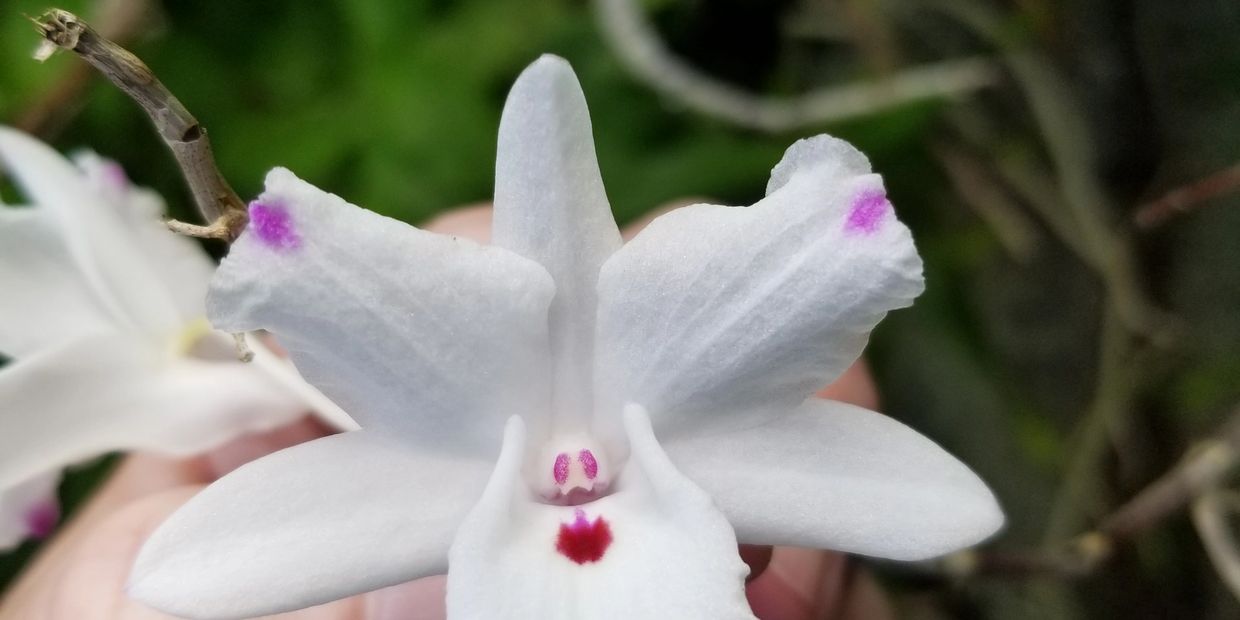Species of the Month - Dendrobium annae
Each month we will feature a different Dendrobium species, on occasion, a primary hybrid, which we feel is well worthy of growing.
We will provide a photo of the flower, of the plant if possible, and some cultural information. If we know of a grower who is selling the plants, we will list that too.

Dendrobium annae - Section Calcarifera
About Dendrobium annae
This species of the section calcarifera comes from Sumatra as well as Java in western Indonesia.
Plants actually start blooming at a rather small size, about 6 inches (15.24 cm), but plants can get very large, up to 4 feet (121.92 cm) tall. The plant has clustered canes which are slightly ribbed; carrying lanceolate, oblique, obtuse, bilobed leaves. Plants naturally bloom in the fall, though in cultivation, mine bloom off and on from late spring through the fall on up to 4 inch (10.16 cm) long inflorescences. Floral bracts are triangular and with usually only 2 flowers, sometimes more on larger plants, which are short lived, up to 3 days.
Temperature: Plants are hot to warm growing epiphytes.
Water: During the growing season, they like a lot of water. The average heaviest rainfall per month being 22.9 inches (58.17 cm) while the driest monthly average rainfall is 9.9 inches (25.15 cm) of rain. So these plants like humidity and water. I have grown 2 plants here in south Florida; one in a plastic pot with sphagnum moss, the other in a plastic Vanda basket with sphagnum moss. Both plants did well in the same location at first, but once the plants got more roots and more established, the plant in the Vanda basket couldn't keep moist enough and eventually declined, while the plant in the smaller plastic pot and sphagnum moss is still thriving. I've even repotted into a very slightly larger pot where it is outside getting all of nature's rain and it's still loving it. I would still recommend a quick draining medium, or adding some aliflor/hrydroton/leca to the sphagnum, especially if you are not too familiar with growing with sphagnum moss by itself. So once new roots form in the spring, more water, let mix get slightly dry in winter, but no complete winter rest.
Light: Very bright light. I give them about 3 t 4 hours of direct morning sun per day, then dappled light the rest of the day for another 6 hours minimum. Growing indoors would require supplemental lighting.
Fertilizer: all year. Heavier during active growth, sparingly to almost none during the rest period. During the spring, I add a good quality, balanced, timed release fertilizer like Nutricote/Dynamite (13-13-13). Any time during the year can be supplemented with a liquid fertilizer. I tend to use Cal/Mag.
This plant may not have a profusion of blooms all at one time, but the pure white flowers with the lavender- purple splotches at the apex of the petals and the lip, along with the red splotch at the base of the lip close to the column and the lavender-purple markings on the anther cap make this a highly sought after species. The markings which I have seen are highly variable as far as size, so if you can buy one in bloom, it would be the best choice. I have never seen a really bad one however. I have seen them for sale, small plants, ranging from $35 - $250 USD. If you can find one, I highly recommend it.